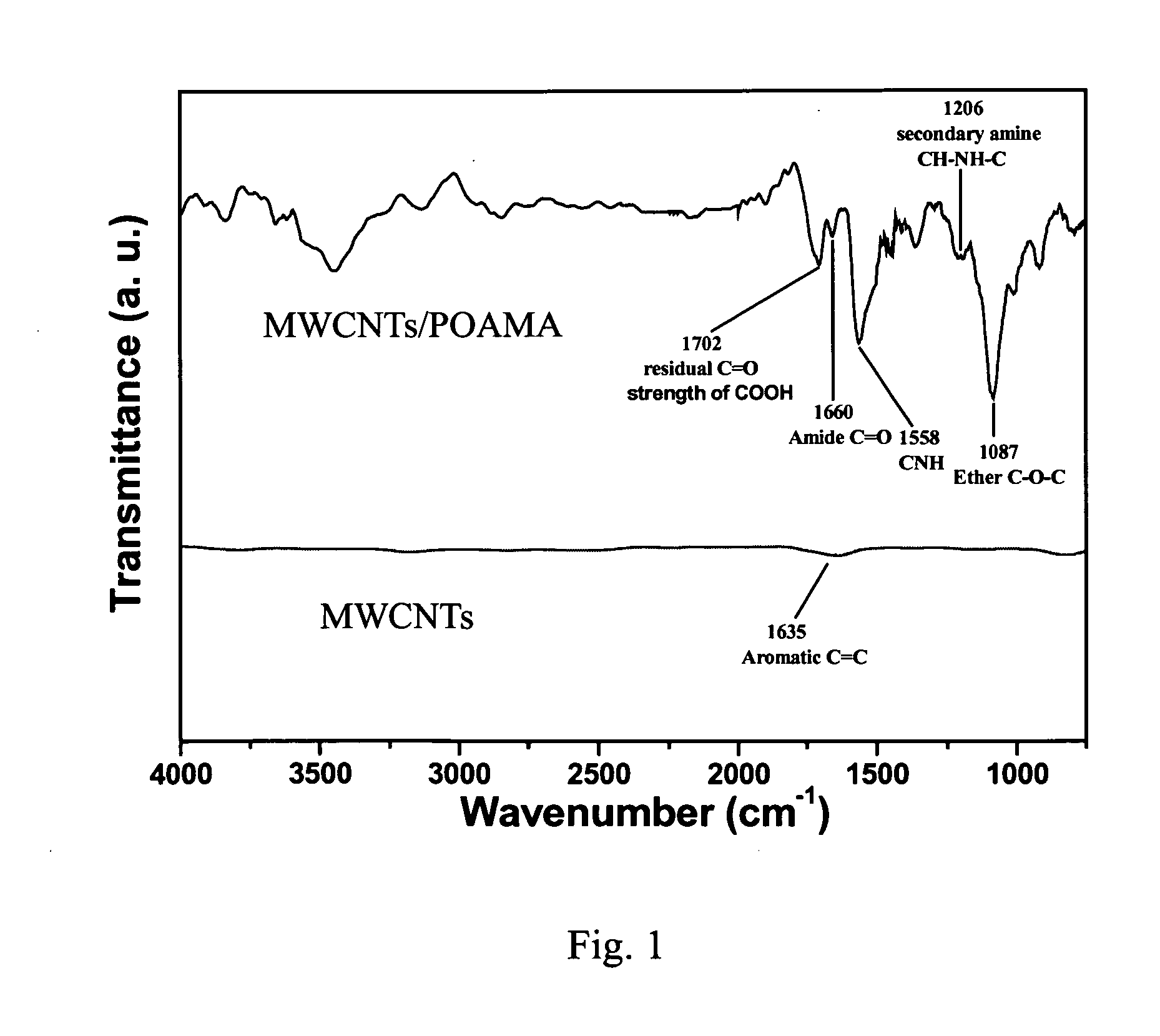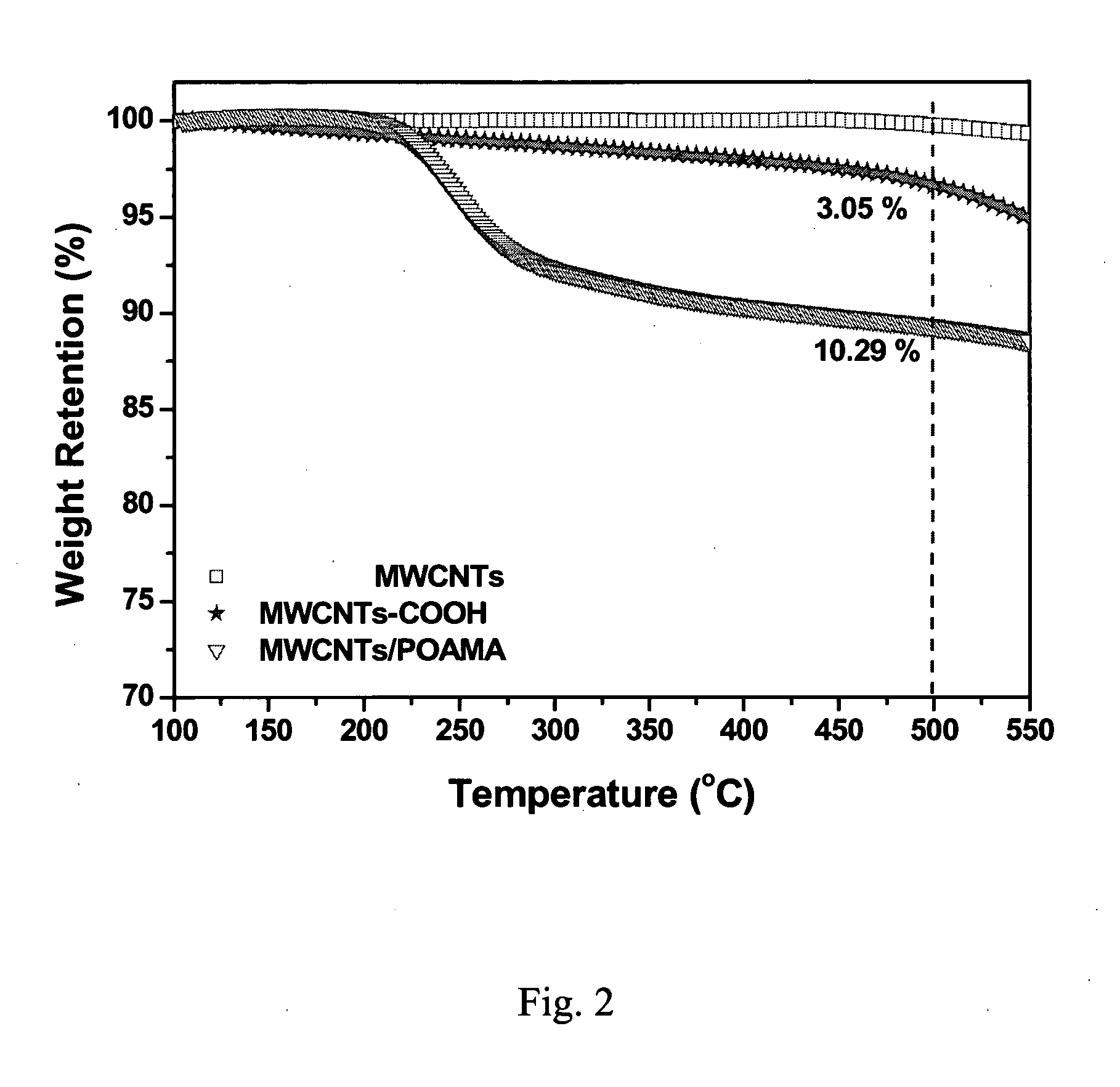Composite substrate for counter electrode of dye-sensitized solar cell
a solar cell and counter electrode technology, applied in the direction of electrolytic capacitors, solid-state devices, nano-informatics, etc., can solve the problem that the electrically conductive glass substrate has a relatively high share in the manufacturing cost of dssc, and achieve excellent mechanical properties, high electrical conductivity, and high thermal stability
- Summary
- Abstract
- Description
- Claims
- Application Information
AI Technical Summary
Benefits of technology
Problems solved by technology
Method used
Image
Examples
preparation example 1
Reactive Carbon Nanotubes Modified by Acyl Chlorination-Amidization Reaction
[0044]Scheme 1 depicts an overview of procedures for preparing reactive carbon nanotubes modified by acyl chlorination-amidization reaction.
[0045]15.68 g (0.160 mole) of anhydrous maleic anhydride (MA) was slowly added to a reactor charged with 0.16 mole of poly(oxypropylene) diamine, Jeffamine® D-2000, and then stirred mechanically at 25° C. for 24 hours. The resulting product mixture was washed with deionized water several times, and dried at 100° C. to obtain maleic anhydride-polyether diamine (abbreviated as POAMA). 8 g MWCNTs and 400 mL of nitric acid were introduced into a three-neck flask, where an acidification was carried out under refluxing at 120° C. for 8 hours. The acidified MWCNTs were removed from the falsk and washed with terahydrofuran (THF), dried at 100° C., and then introduced into another three-neck flask. Nitrogen was introduced into the flask after vacuuming, 300 ml thionyl chloride (S...
preparation example 2
Preparation of CNT-mPOP400-amine and CNT-mPOP2000-amine by Free-Radical Modification
[0048]Scheme 2 depicts an overview of covalent grafting procedures for preparing the modified carbon nanotubes.
[0049]The preparation of poly(oxypropylene) diamines with various molecular weights (Mw 400 and 2000 g / mol) bearing one maleic anhydride (abbreviated as mPOP-amine) was carried out in a glass reactor equipped with a stirrer. The designated amount of maleic anhydride (15.68 g, 160 mmol) was slowly added to a reactor charged with polyether amine (160 mmol), and then stirred mechanically at 25° C. for 24 h. In order to prepare carbon nanotubes modified by polyether amine (abbreviated as CNTs-mPOP-amine), first 12 g MWCNTs was suspended in 600 ml THF by shear mixed for 1 h and ultrasonication for 15 min. Subsequently, mPOP-amine-400 (1.33 g, 2.67 mmol) and mPOP-amine-2000 (5.6 g, 2.67 mmol) dissolved in 10 ml THF was slowly added into MWCNT suspension, and the mixture was further shear mixed at ...
example 1
[0054]The graphite powder used in Example 1 consisted of not more than 10% of particles larger than 40 mesh (420 μm in diameter), about 40% of particles between 40 mesh and 60 mesh (420-250 μm in diameter), and about 50% of particles between 60 mesh and 80 mesh (250-177 μm in diameter).
Preparation of BMC Material and Specimen
[0055]1. 192 g of a solution was prepared by dissolving 144 g of vinyl ester resin resin and 16 g of styrene-monomer-diluted polystyrene (as a low shrinking agent) in 32 g of styrene monomer as a solvent. 3.456 g of TBPB was added as an initiator, 3.456 g of MgO was added as a tackifier, and 6.72 g of zinc stearate was added as a mold releasing agent.[0056]2. The solution resulting from step 1, and 448 g of graphite powder were poured into a Bulk Molding Compound (BMC) kneader to be mixed homogeneously by forward-and-backward rotations for a kneading time of about 30 minutes. The kneading operation was stopped and the mixed material was removed from the mixer to...
PUM
| Property | Measurement | Unit |
|---|---|---|
| specific surface area | aaaaa | aaaaa |
| length | aaaaa | aaaaa |
| diameter | aaaaa | aaaaa |
Abstract
Description
Claims
Application Information
 Login to View More
Login to View More - R&D
- Intellectual Property
- Life Sciences
- Materials
- Tech Scout
- Unparalleled Data Quality
- Higher Quality Content
- 60% Fewer Hallucinations
Browse by: Latest US Patents, China's latest patents, Technical Efficacy Thesaurus, Application Domain, Technology Topic, Popular Technical Reports.
© 2025 PatSnap. All rights reserved.Legal|Privacy policy|Modern Slavery Act Transparency Statement|Sitemap|About US| Contact US: help@patsnap.com



